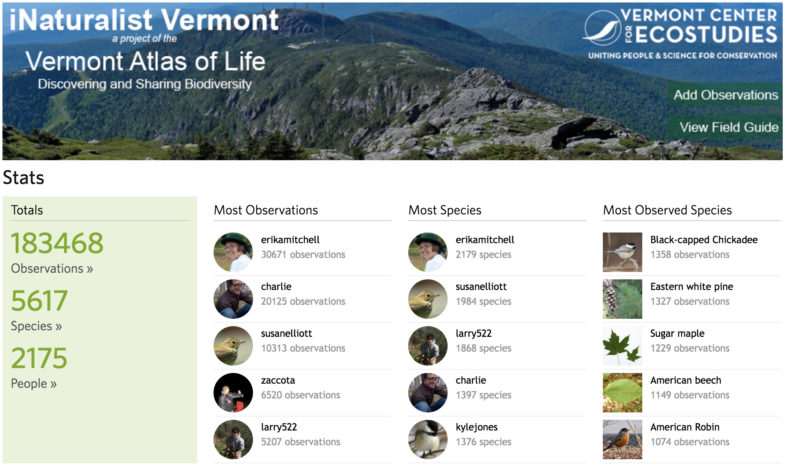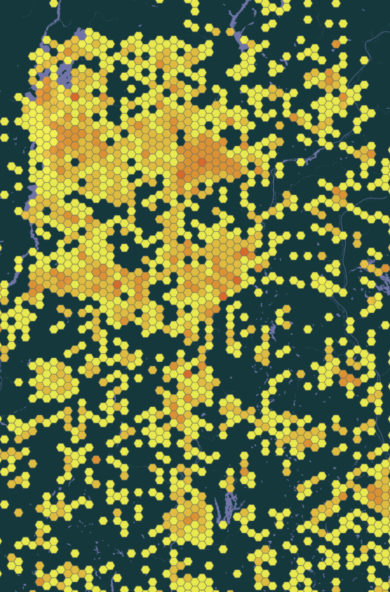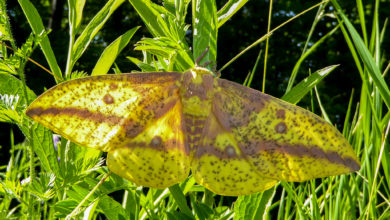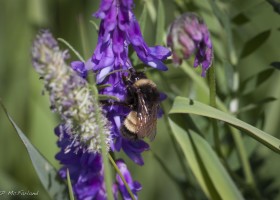With a tap on his smartphone and a click to submit to iNaturalist Vermont, Noel Dodge added the 150,000th record this year on June 15th, a Black Ash tree growing near Otter Creek. And observations kept on coming to iNaturalist Vermont, with more than 183,000 observations representing more than 4,000 species contributed by 2,175 citizen scientists. Over the past 5 years iNaturalist Vermont, a project of the Vermont Atlas of Life, has become a big data biodiversity resource for the Green Mountain State.
2017 was a big year for iNaturalist Vermont. We had 1,057 naturalists contribute over 56,250 observations representing more than 3,850 species. Over 1,325 naturalist helped to identify and verify data. And we joined the more than 73,000 iNaturalists worldwide that submitted over 3.5 million observations in 2017! Check out the 2017 year in review statistics dashboard, and if you’re an iNaturalist you can see your year in review too.
iNaturalist Vermont Research Grade Observations
An observation submitted to iNaturalist becomes what is called ‘research grade’ when it has: a date, has latitude and longitude coordinates, photos or sounds of the observation, and the community agrees on the identification to species level. We have nearly 125,000 research grade observations comprising over 4,000 species in the iNaturalist Vermont database. These data are shared continually with the Global Biodiversity Information Facility, an international open data infrastructure that allows anyone, anywhere to access data about all types of life on Earth, shared across national boundaries via the Internet.
Some New and Amazing Discoveries in 2017 from iNaturalist Vermont
Odonata
By most any measure, the 2017 field season of the Vermont Dragonfly and Damselfly Atlas (VDDA) was amazing. Volunteers added 1,605 records to our growing dataset, which now stands at 10,544 records. That includes the addition of two new species to the Vermont fauna in 2017: Cordulegaster erronea (Tiger Spiketail) and Somatochlora incurvata (Incurvate Emerald).
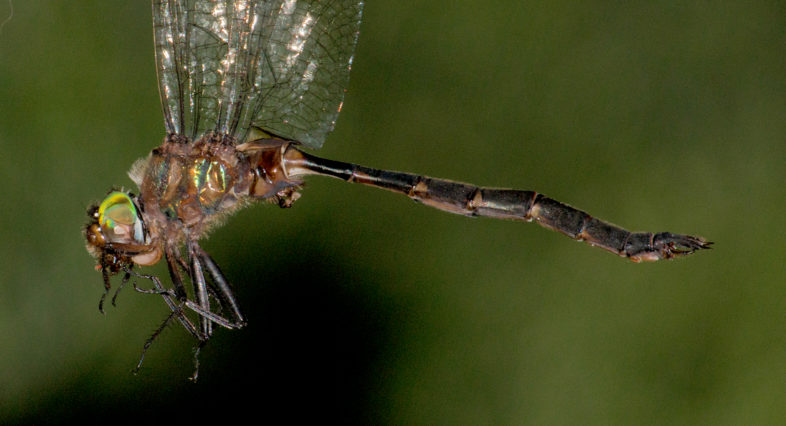
The first Incurvate Emerald found in Vermont. Click on the image to see the report on iNaturalist Vermont. / © Josh Lincoln
The first big news came from the Black River in Springfield. On July 31, Dale Ferland, an angler who likes to poke around rivers, snapped a photo of a dragonfly perched on the shoreline. Kelly Stettner, who’s doing great work educating folks about the river, posted Dale’s image to iNaturalist Vermont, where project curators first saw it. Needless to say, we were happy — and surprised. It was Vermont’s first Cordulegaster erronea (Tiger Spiketail). The other big discovery was Somatochlora incurvata (Incurvate Emerald). On September 16, Josh Lincoln and Mike Blust set out on the Victory Bog slog. And after the two-hour bushwack, and then 45 minutes on the bog, each of them had achieved victory in Victory: at long last, Vermont’s first Somatochlora incurvata (Incurvate Emerald). This elusive species is among the rarest North American dragonflies, known only from scattered records throughout the upper Midwest and northeastern North America.
Moths
iNaturalists were able to capture an amazing outbreak of Pine Imperial Moths (Eacles imperialis ssp. pini)in the northern Champlain Valley this year. The 1995 landmark publication Moths and Butterflies of Vermont: A Faunal Checklist, noted a specimen in the Carl T. Parsons Entomological Collection at UVM from July 1893, and reported that It was apparently last seen in Vermont in 1934. The iNaturalist Vermont database now has 20 records, including a caterpillar that was found feeding on Red Cedar, potentially a new host plant for this moth.
Thanks to the tireless efforts of both professional and amateur Lepidopterists, since the 1995 landmark publication Moths and Butterflies of Vermont: A Faunal Checklist, nearly 400 new moth species have been found in Vermont. Preliminary results show us that there are now over 2,200 species of moths known from Vermont. And, there are likely many more awaiting our discovery.
Since 2013, professional biologists and naturalists have contributed moth observations to the Vermont Atlas of Life through our iNaturalist Vermont. Many of us turn on special lights in our backyards on summer nights to find hundreds of moths and other insects gathering on our sheets, hunt fields and forest for day-flying moths, and place rotten fruit bait out to attract other moths. Many of these moths can be identified from good photographs (although some are impossible without dissection and examination under a microscope). With today’s amazing digital photography technology, coupled with the newer Peterson’s Field Guide to Northeastern Moths and web sites like iNaturalist Vermont, BugGuide, Moth Photographers Group, or Moths of Eastern North America Facebook Group, moth watching (aka mothing) has become increasingly popular.
Moth watchers have added a whopping 91 news species to the Vermont checklist via iNaturalist Vermont and have documented 864 species across the state. What’s even more amazing is that we’ve recorded over 15,000 moth observations, which help to understand their phenology, habitat use and range in Vermont like never before.
Bumble Bees
Observers added 14 records across Vermont for the State Threatened Yellow-banded Bumble Bee (Bombus terricola). Populations of this species appear to be rebounding somewhat. Once common and found throughout the northeast and south into Georgia, B. terricola populations have experienced a dramatic decline over the past 15 years.
Plants
Nearly 600 iNaturalists added over 24,000 observations comprising 845 verified species of plants in 2017. Erika Mitchell contributed the most with 8,608 observations – an average of 23 plant species a day! This is even more impressive considering she spent a large portion of the late fall in France (where she also added a great deal to iNaturalist). Erika also recorded the greatest number of plant species – 634. Meanwhile, Tom Norton helped identify over 11,500 Vermont plant records.
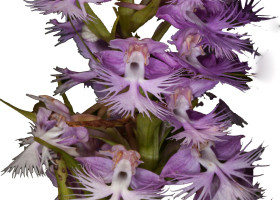 A number of rare or conservation concern species were recorded by observers. For example, we had 39 observations of 14 species of threatened orchids! Charlie Hohn added a number of species such as Buxbaum’s Sedge (Carex buxbaumii), Small White Aster (Symphyotrichum racemosum), Pod-grass (Scheuchzeria palustris), and others.
A number of rare or conservation concern species were recorded by observers. For example, we had 39 observations of 14 species of threatened orchids! Charlie Hohn added a number of species such as Buxbaum’s Sedge (Carex buxbaumii), Small White Aster (Symphyotrichum racemosum), Pod-grass (Scheuchzeria palustris), and others.
The most frequently added plant species was Sensitive Fern – an easily identified species whose fruiting stalks are visible through the winter where snow is not too deep. This is followed in abundance by common tree species – American Beech, Eastern White Pine, Sugar and Red maples. While data on these common species may not seem important at first glance, it is crucial. In the face of invasive species, climate change, and forest fragmentation, what was once common can become rare. In the past, towering American Elms filled our floodplains and stately American Chestnuts probably lined Lake Champlain. Both of these species were almost eradicated by introduced tree diseases. We don’t have detailed data on the past distribution for these once-common species, which is making it harder to restore disease resistant populations. If the Hemlock Woolly Adelgid spreads north and devastates Eastern Hemlock the way it did to forests to the south, the over 900 Vermont records of this species may turn out to be vital in restoration efforts.
In 2016, around 14,000 plant records were added to iNaturalist Vermont. Thus an increase of over 10,000 records from 2016 to 2017. The New Year promises to be even more productive for biodiversity data collection!
There’s a whole lot more that was discovered and you can check them out at iNaturalist Vermont.
Explore the 2017 Photo-Observation of the Month Winners
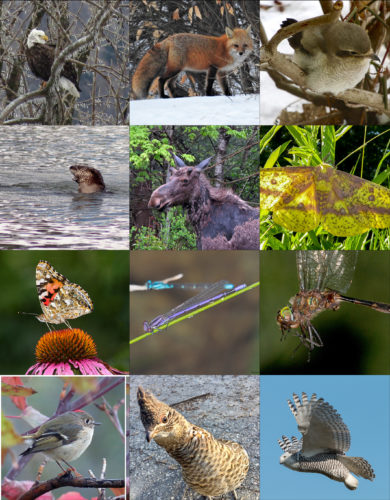 Each month, iNaturalists ‘fav’ any observation they like to vote for the iNaturalist Vermont photo-observation of the month. Check out these awesome winners from 2017.
Each month, iNaturalists ‘fav’ any observation they like to vote for the iNaturalist Vermont photo-observation of the month. Check out these awesome winners from 2017.
We hope you’ll join iNaturalist Vermont and help us make this biodiversity database even stronger. Make iNaturalist Vermont your New Year’s resolution in 2017!
